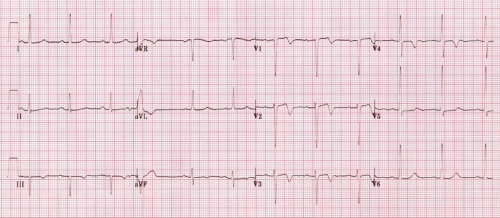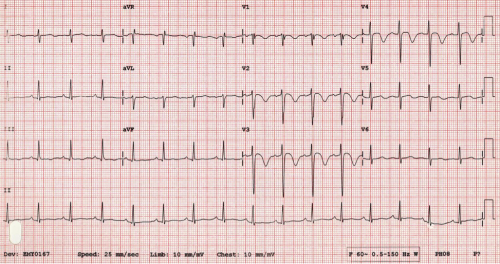Table of Contents
ECG analysis
The ECG is one of the most common investigations in the ED and one of the most useful diagnostic tools. Recognising what appears 'different' or atypical or unusual is problematic as variations occur due to physical training and ethnic variations and some drugs cause changes which are consequential vs dangerous.
Common, training induced, findings in athletes:
- Sinus bradycardia
- First-degree AV block
- Incomplete RBBB
- Early repolarization
- Isolated QRS voltage criteria for left ventricular hypertrophy
90% of healthy young men have concave ST-segment elevation of 1-3mm in ≥1 precordial leads.
Analysing parts of the ECG
P wave |
|
|---|---|
| peaked P | • R atrial hypertrophy eg. Pulmonary hypertension, tricuspid stenosis |
| broad and bifid P | • L atrial hypertrophy eg. Mitral stenosis |
PR interval |
|
|---|---|
| 1O HB | • >200ms, may be normal variant • hyperkalaemia, ↑vagal tone, drugs, myocarditis • no Rx required |
| 2O HB | Mobitz I, (Wenckebach) • progressive prolongation of PR until non-conducted P • assoc with some drugs eg β blockers, Ca blockers, Digoxin • usually benign |
 |
|
| 2O HB | Mobitz II (Hay block) • intermittent non-conducted P waves • PP remains constant • RR constant multiple • structural damage |
 |
|
| WPW | • short PR, delta wave |
 |
|
| LGL | • short PR, narrow QRS, ?real diagnosis |
| PR segment | • depression or elevation associated with MI indicates atrial involvement and carries a poor prognosis • suggests atrial ischaemia/infarction |
QRS complex |
|
|---|---|
| LBBB | • QRS>120ms • dominant S-V1, broad R-V6 • Sgarbossa criteria for STEMI with LBBB |
 |
|
| RBBB | • QRS>120ms • RSR' V1-3; wide, slurred S lat leads • does not affect MI interpretation criteria |
 |
|
| Epsilon wave | • small positive deflection (‘blip’ or ‘wiggle’) buried in the end of QRS complex. • caused by post-excitation of the myocytes of RV • also described in post MI; RV infarction; infiltration disease, and sarcoidosis. • the most characteristic finding in arrhythmogenic RV dysplasia (ARVD/C) |
 |
|
| Hyperkalaemia | • The only condition that causes the QRS complex to be ≥ 0.24 sec is hyperkalemia • regardless of the rhythm or the presence of an underlying intraventricular conduction delay • the hyperacute T waves are also consistent with hyperkalemia |
 |
|
QTc interval |
|
|---|---|
| Long QT syndrome | • QT>450ms • life threatening |
 |
|
Causes of long QT
- Hypokalaemia.
- Hypomagnesaemia.
- Hypocalcaemia.
- Hypothermia.
- Myocardial ischemia.
- ROSC Post-cardiac arrest.
- Raised intracranial pressure.
- Congenital long QT syndrome.
Drug related causes of long QTc
many drugs are associated with long QTc but some common ones include:
| anti-arrhythmics | amiodarone, disopyramide, procainamide, quinidine, sotalol, dofetilide, ibutilide |
|---|---|
| anti-psychotics | chlorpromazine, clozapine, haloperidol, quetiapine, risperidone, thioridazine |
| anti-depressants | amitryptiline, citalopram, desipramine, doxepin, fluoxetine, impramine, nortriptyline, paroxetine, sertraline, venlafaxine |
| anti-emetics | ondansetron, prochlorperazine |
| antibiotics | azithromycin, ciprofloxacin, clarithromycin, erythromycin, fluconazole, ketoconazole, levofloxacin, moxifloxacin, ofloxacin, trimethroprim |
ST segment |
|
|---|---|
| ST depression | • usually needs to horizontal or downsloping to be relevant • ≥0.5mm at J pt in ≥2 contiguous leads suggests ischaemia • greater depression → worse prognosis • upsloping ST depression with de Winter T waves = highly specific for LAD occlusion • upsloping ST depression = non-specific |
| ST elevation | • MI - can be convex, concave or obliquely upsloping. Usually with reciprocal ST depression in electrically opposite leads • pericarditis, Benign Early repolarisation, LBBB, LVH & Brugada |
| subtle ant MI vs normal variant ST elevation | |
| Brugada Syndrome | • Coved ST: V1-V3 • tendency to VF |
 |
|
| Early repolarisation | • ST sharply rising, usually concave upwards with large symmetrical T • present in ≤50% Caucasian athletes and ≤90% Afro-Caribbean athletes • T amplitude should be >4x ST elevation |
 |
|
| Pericarditis | • ST concave upwards in most leads except aVR • no reciprocal ST depression except aVR |
 |
|
T waves |
|
|---|---|
| peaked T waves | • hyperkalaemia • normal variant • occasionally ischaemia • hypertrophy • in general, T changes are non-specific and therefore best assessed 'in context' |
| Wellens Syndrome | • deeply inverted (most common) or biphasic T in V1,2 • impending extensive MI with LAD occlusion |
  |
|
| de Winter T waves | • rare - ~2% prox LAD occlusions • upsloping ST depression in precordial leads • peaked symmetrical T waves starting from below isoelectric baseline • subtle ST elevation aVR - may appear later • highly predictive of acute LAD occlusion |
 |
|
| inverted T waves | • inverted T waves is a normal finding in leads III, aVR, aVL, and V1 in adults • T waves changes are grouped into lead groups: anterior (V2, V3, V4), lateral (I, aVL, V5, V6), and inferior (II, aVF) • Lateral T-wave inversion is associated with increased risk of mortality and CHD. T-wave inversion in anterior lead group is independently associated with the risk of CHD, but not mortality. T-wave inversion in the inferior lead group probably benign. Prognostic Sig of T inversion 2021 • Global inversion refers to T inversion in all std leads except aVR. Seen in: • L main coronary artery or equivalent MI • Takotsubo cardiomyopathy • Kounis syndrome • apical hypertrophic cardiomyopathy • acute pericarditis • acute cerebrovascular event, electrolyte abnormalities, phaeochromocytoma • pulmonary embolism, and pulmonary edema The significance of inverted T waves beyond V1,2 is debatable. Inf/lat does requires Ix. Consider: • ARVD • congenital coronary micro-fistulae and other cardiomyopathies • T inversion cases |
|---|---|
 |
other waves |
|
|---|---|
Q | • QS complex in V1 is normal |
 |
|
U | • same direction as T wave • prominent U seen with ↓(Mg, Ca, K, temp) • <25% of T wave height • inverted usually related to myocardial ischaemia |
 |
|
J | hypothermia |
Short PR interval
Wolf Parkinson White (WPW)
- a combination of the presence of a congenital accessory pathway and episodes of tachyarrhythmia
- associated small risk of sudden death
presentation can be varied, with variation depending also on age:
- chest pain, palpitations, SOB
- irritability, pallor
- exercise intolerance
ECG features:
- PR interval <120ms
- Delta wave – slurring slow rise of initial portion of the QRS
- QRS prolongation >110ms
- ST, T wave discordant changes – i.e. in the opposite direction to the major component of the QRS complex
Lown-Ganong-Levine (LGL) syndrome
- a pre-excitation rhythm
- in the setting of tachycardia normal/narrow complex QRS with short PR interval (<0.12s) - there is no Delta wave seen in WPW
- no increased mortality risk
- some suggestion that this is not really a syndrome at all.
Mobitz II (Hay block)
- Intermittent non-conducted P waves without progressive prolongation of the PR interval
- PP interval remains constant while RR maintains constant multiple
- usually as a result of structural damage vs Mobitz I which is more functional (drugs, vagal tone etc)
- MI, fibrosis, inflammatory and autoimmune destruction
- more likely to become haemodynamically unstable, severe brady and progress to Complete Heart Block
- risk of asystole 35% per year
Wellens syndrome
![]() A pre-infarction stage of coronary artery disease and heralds an impending extensive myocardial infarction of the anterior wall
A pre-infarction stage of coronary artery disease and heralds an impending extensive myocardial infarction of the anterior wall
*highly specific for a critical stenosis of the left anterior descending artery (LAD)
- A pattern of deeply inverted or biphasic T waves in V2-3. Unusually, and atypically, the ECG changes appear after pain has resolved
- may be pain free at time ECG is taken and have normally or minimally elevated cardiac enzymes
- extremely high risk for extensive anterior wall MI within the next few days to weeks.
Diagnostic criteria:
- Deeply-inverted or biphasic T waves in V2-3 (may extend to V1-6)
- Isoelectric or minimally-elevated ST segment (< 1mm)
- No precordial Q waves
- Preserved precordial R wave progression
- Recent history of angina
- ECG pattern present in pain-free state
- Normal or slightly elevated serum cardiac markers
Two patterns of T-wave abnormality in Wellens syndrome:
- Type A – Biphasic, with initial positivity and terminal negativity (25% of cases)
- Type B – Deeply and symmetrically inverted (75% of cases)
LVH criteria
Left Ventricular Hypertrophy ECG Criteria
| Cornell criteria | Add the R wave in aVL and the S wave in V3. If the sum is greater than 28 millimeters in males or greater than 20 mm in females, LVH is present. | |
|---|---|---|
| Modified Cornell Criteria | Examine the R wave in aVL. If the R wave is greater than 12 mm in amplitude, LVH is present. | |
| Sokolow-Lyon Criteria | Add the S wave in V1 plus the R wave in V5 or V6. If the sum is greater than 35 mm, LVH is present. Non Voltage Criteria considered essential to be diagnostic: Increased R wave peak time > 50 ms in leads V5 or V6 ST segment depression and T wave inversion in the left-sided leads: AKA the left ventricular ‘strain’ pattern | |
| Romhilt-Estes LVH Point Score System If the score equals 4, LVH is present with 30% to 54% sensitivity. If the score is greater than 5, LVH is present with 83% to 97% specificity. | Points | |
| Amplitude of largest R or S in limb leads ≥ 20 mm | 3 | |
| Amplitude of S in V1 or V2 ≥ 30 mm | 3 | |
| Amplitude of R in V5 or V6 ≥ 30 mm | 3 | |
| ST and T wave changes opposite QRS without digoxin | 3 | |
| ST and T wave changes opposite QRS with digoxin | 1 | |
| Left Atrial Enlargement | 3 | |
| Left Axis Deviation | 2 | |
| QRS duration ≥ 90 ms | 1 | |
| Intrinsicoid deflection in V5 or V6 > 50 ms | 1 |
References include:
https://litfl.com/pre-excitation-syndromes-ecg-library/
https://rebelem.com/five-ecg-patterns-you-must-know/
BMJ ECG danger
BMJ - international criteria for ECGs in athletes 2017
https://reference.medscape.com/features/slideshow/ecgs-life-threatening#page=1
https://litfl.com/killer-ecg-patterns/
https://www.aliem.com/cant-miss-ecg-findings/
Circulation: Arrhythmia and electrophysiology 2012
Early repolarisation syndrome - cause of sudden death 2015
https://litfl.com/benign-early-repolarisation-ecg-library/
Healio: LVH review
ECG blog
4th universal definition of Myocardial infarction 2018
Heart Rhythm J: variability of Epsilon wave assessment review 2016
World J Cardiol: cardiac and non cardiac causes of T wave inversion
Euro Heart J suppl. Inverted T waves - when to worry
Medscape ECG challenge - hyperkalaemia


